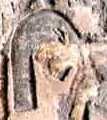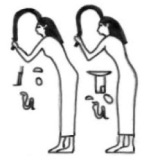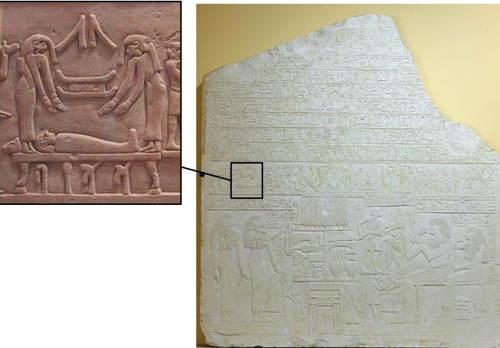Not only on ancient Egyptian funerals were mourners shaking or pulling hair. Also in the Hereafter, supernatural beings were responsible of these kinds of practices. Book of Caverns show in the second section the god Re with head of crocodile walking towards nine divinities that hold their front lock of hair, the text says:
“Oh! The one who mourns, big of lock syt and of strong cry in the West protect the king.
“Oh! The one of the hair who is on the moan [1]
“Oh! These nein gods that mourn for Osiris, that cry for that one who is in front of Amduat.
Oh, look at me! I am walking towards you I pass by your caverns I call you and you scream to me. Duaty, he feels happy with your voice, those ones who mourn in Duat, the ones with secret faces, under you lock of hair syt[2], your voice is for me. I call you together , I light you up[3], mourners…you lead me and I walk towards you[4], I really protect your souls, I make you have my light, I take away the darkness that is on you…big mourners, having goods, you who are over the lock of hair syt in the land of the West . I walk on the ground I came from in my first birth”.
In the Duat the iakbyw (mourners) work for the regeneration of the dead god Osiris, crying and holding their locks of hair. And at the same time, that resurrection provides protection and light for their souls . When the deceased is in darkness the mourners are “under the lock of hair” covered with this hair:
When the deceased revives and can walk in the Duat, the expression is just the contrary: “over the lock of hair” :
They are not anymore under the hair, but they have come to the light and the dead is “happy with the youth of his body”
The words syt and swt describe the front lock of hair the mourners pull. We find also the term syt in The Coffin Texts in chapters 799 and 532, where tells about « tying the lock syt in Heliópolis the day of cutting the samt » and in several documents from the New Kingdom we also can read how a male characters are the mourners of Re and hold their lock of hair syt/swt[5] they grant that Osiris can be justified in the Hereafter [6]. At this point it is also interesting to say that in the chapter 339 of the Coffin texts, the day of the resurrection of Osiris is the day of “shaving the mourning women”.
Again, also in the Hereafter, the nwn m gesture is a part of the mourning rite, as a sign of pain but also as a way of making the dead revive and make easier his way in to the Hereafter.
[1] . Pay attention in the word used for moan (samt), which has de determinative of the hair. In the cenotaph of Seti I in Abydos we read: “Oh! The one of the hair, over his moan, who puts his voice, to whom the souls call”
[2] . Piankoff translated the preposition as “carrying” the locks syt. But the first meaning of that preposition is “under”. If we take the sentence as “under the locks of hair syt” it made sense with the previous expression: “of secret faces”, so, “hidden under the hair”.
[3] The light comes after the darkness of the death.
[4] Mourners guide the dead with their screams. The deceased is blind (dead) and on the way to the new light (new life).
[5] Piankoff and Jacquet-Gordon, 1974, p. 55, Pl. 10.
[6] Berlin Papyrus 6, Piankoff and Jacquet-Gordon, 1974, p. 57.








